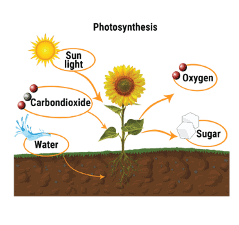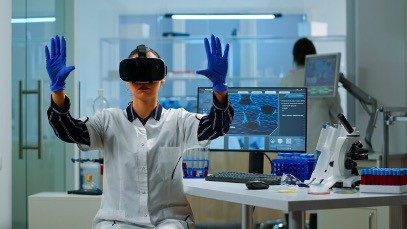Life needs a steady flow of energy in order to survive and proliferate. Photosynthesis provides the energy gradient that keeps our biosphere alive. By breaking and forming chemical bonds against the chemical equilibrium, photosynthetic organisms stabilize the fleeting stored energy in a photon. The atmosphere contains more than 20% oxygen that provides the basis of energy gradient that sustains life close to the Earth’s surface. Oxygen is produced by the breakdown of water by the majority of photosynthetic organisms. The electrons released during this process can be utilized to convert inorganic carbon to generate organic molecules, which can then be utilized to construct biological components. By oxidizing the produced molecules and recombining electrons with oxygen and protons to produce water, the stored redox energy can be released. This is the mechanism that allows oxygen-dependent respiration to generate energy. A water-oxygen cycle is completed by photosynthesis and oxygen-dependent respiration.

Plants use photosynthesis to absorb energy from the sun and convert it into metabolic energy, which is then used to support almost all life on Earth. Photosynthesis is necessary for plant growth. Growth rate is also proportional to photosynthetic rate. In addition to light and carbon dioxide, continued growth necessitates the acquisition of water and nutrients, as well as competition with nearby plants in many circumstances. The plant must invest biomass in order to obtain these resources, and respiration is required to keep all of the plant's living cells alive.
Basically, we can summarize the process of photosynthesis as follows; photosynthesis involves the use of light energy to convert carbon dioxide and water into sugar, oxygen and other organic compounds.
What is Virtual Lab?
Computer-generated 3D real-time environments in which people interact with the simulated environment are referred to as virtual reality. These environments can be as visually appealing as any movie, but they vary from movies in that users’ interactions have an effect on the environment.
Virtual reality has the potential to benefit experimental and behavioral research because the signs presented are realistic, allowing responders to become involved in the task in ways that traditional text and picture interactions may not allow.

What is in Photosynthesis Virtual Lab?
In VRLab Academy, you can find a virtual Photosynthesis Experiment that belongs to Biology virtual lab section. The aim of this virtual lab is to explain the necessity of energy for the continuation of life and the importance of photosynthesis to life. After a brief theoretical information, virtual photosynthesis experiment starts with adding water and adjusting light intensity. Data are collected with carbon dioxide and oxygen sensors. At the end, photosynthesis rate, the effect of light intensity on photosynthesis are obtained.
Take a look at all experiments at VRLab Academy and enhance your teaching power with us.
References:
- Hohmann-Marriott, M. F., & Blankenship, R. E. (2011). Evolution of Photosynthesis. Annual Review of Plant Biology, 62(1), 515–548. doi:10.1146/annurev-arplant-042110-103811
- Evans, J. R. (2013). Improving photosynthesis. Plant physiology, 162(4), 1780-1793.
- Harrison, G. W., Haruvy, E., & Rutström, E. E. (2011). Remarks on Virtual World and Virtual Reality Experiments. Southern Economic Journal, 78(1), 87–94. doi:10.4284/0038-4038-78.1.87